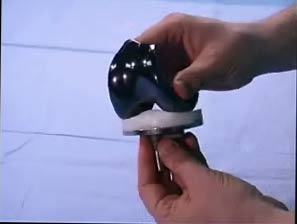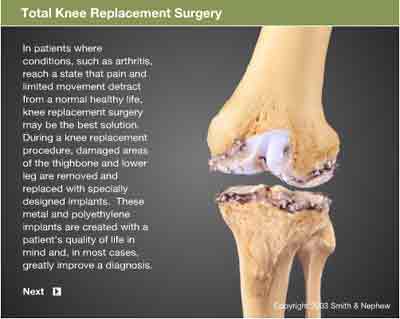|
Mis Knee Home |
Anatomy |
Arthritis |
Partial Knee Replacement |
Total Knee Replacement |
Less Invasive Total Knee |
What to Expect On Surgery Day |
Post Operative Care |
Knee Rehabilitation |
Knee Non-Surgical Solutions |
Life After Knee Replacement
Total Knee Replacement Surgery If you are considering knee surgery the following total knee replacement information might help you understand the procedure and implants better. Your knees work hard during your daily routine, and arthritis of the knee or a knee injury can make it hard for you to perform normal tasks. If your injury or arthritis is severe, you may begin experience pain when you’re sitting down or trying to sleep. Sometimes a total knee replacement is the only option for reducing pain and restoring a normal activity level. If your and your doctor decide a total knee replacement is right for you, the following information will give you an understanding about what to expect. A total knee replacement involves cutting away the damaged bone of the knee joint and replacing it with a prosthesis. This “new joint” prevents the bones from rubbing together and provides a smooth knee joint. Click the image below to view a movie of how the total knee implant components work together... (585k - Requires:Windows Media Player, Download Here) 
 Implant Components
Implant Components
In the total knee replacement procedure, each prosthesis is made up of four parts. The tibial component has two elements and replaces the top of the shin bone or tibia. This prosthesis is made up of a metal tray attached directly to the bone and a plastic spacer that provides the bearing surface. The femoral component replaces the bottom of the thigh bone or femur. This component also replaces the groove where the patella, or kneecap, sits. The patellar component replaces the surface of the knee cap, which rubs against the femur. The patella protects the joint, and the resurfaced patellar button will slide smoothly on the front of the joint. The Procedure Before you are taken to the operating room you’ll be given medication to help you relax, and the anesthesiologist will talk with you about the medications he’ll be using. In the operating room, you will be placed under full anesthesia. Once you are “under” the surgeon will begin by making an incision in your leg to allow access to the knee joint. He’ll then expose the joint and place a cutting jig or template on the end of the femur, or thigh bone. This jig allows the surgeon to cut the bone precisely so that the prosthesis fits exactly. Once the femur is cut, the tibia is cut using another jig for proper alignment of the knee prosthesis. The undersurface of the patella is then removed. Now it’s time to place the prosthesis. This begins with the femoral prosthesis, which is cemented in place using a special bone cement. Next the metal tray is attached to the top of the tibia. This will provide the weight-bearing surface of the femur. The plastic spacer is then attached to the metal tray. This will provide the weight-bearing surface of the femur. If this component should wear out while the rest of the artificial knee is sound, it can be replaced. This is known as a “revision.” Next the patellar button is cemented in place behind the knee cap. Finally, the incision is closed, a drain is put in, and the post-operative bandaging is applied. Click the image below to view an animation of the total knee replacement procedure... (585k - Requires: Windows Media Player, Download Here) 
Returning Home You will be discharged when you can get out of bed on your own and walk with a walker or crutches, walk up and down three steps, bend your knee 90 degrees and straighten your knee. At home you should begin ambulation with a cane as tolerated. Keep your incision clean and dry and watch closely for any signs of infection. You’ll continue your home exercise program and go to outpatient physical therapy, where you will work on an advanced strengthening program and such programs as stationary cycling, walking, and aquatic therapy. Your long-term rehabilitation goals are a range of motion from 100-120 degrees of knee flexion, mild or no pain with walking or other functional activities, and independence in all activities of daily living. |
| Back to Top | Next Topic |
| Contents Courtesy of www.knee-replacement-info.com |